► Special model gets more standard equipment…
► … and some rather unusual green alloy wheels
► Prices start from £85,995 for short-wheelbase model
The iconic Land Rover Defender celebrates its 75th anniversary in 2023 – and Land Rover has already launched a special edition version of the off-roader to commemorate the occasion. It’s called the Defender 75th Anniversary Edition and it’s available in short-wheelbase 90 and mid-wheelbase 110 body styles. Prices start from £85,995 for the former and £89,995 for the latter.
The steep starting price is because the Defender 75th Anniversary Edition is only available in Land Rover’s generously equipped HSE specification. Standard equipment includes Matrix LED headlights, a head-up display, a wireless smartphone charger and an 11.4-inch infotainment system. You also get a posh Meridian stereo system and a 360-degree camera system.
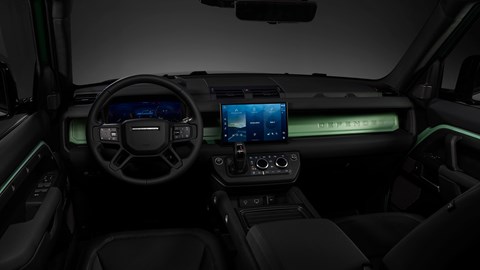
The body and 20-inch alloy wheels are both finished in Land Rover’s iconic Grasmere Green paint, echoing one of the colour schemes you could specify on the previous generation version of the car. Buyers can also choose from either a folding fabric roof or a sliding panoramic sunroof.
You have a choice of two engines. The eco-conscious choice is the P400e plug-in hybrid, which mixes a 2.0-litre four-cylinder petrol engine, an electric motor and 19.2kWh battery pack. Combined, the system produces 398bhp and 472lb/ft of torque, which Land Rover says is enough for a 0–62mph time of 5.6 seconds. The brand also says it can travel up to 27 miles on electric power alone.
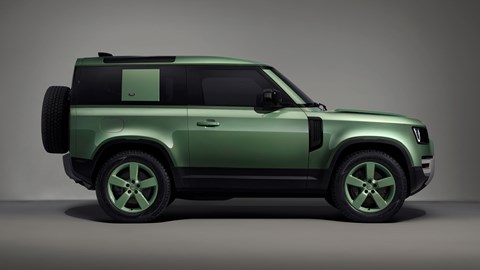
If you haven’t got anywhere convenient to charge up, you can opt for Land Rover’s D300 3.0-litre straight-six mild hybrid diesel engine. It produces 297bhp and 479lb/ft of torque. That’s enough for a 0–62mph time of seven seconds flat and a maximum WLTP fuel economy figure of 32mpg. Not bad for a 2.4-tonne off-roader. Scroll down to read more about the Defender line-up.
What other versions of the Land Rover Defender are available?
You don’t have to have the special edition model. There are cheaper options available. The range kicks off with the Defender Hard Top. This model is aimed at tradies, so it comes with steel wheels, less interior equipment and a starting price of around £51,000.
The Defender Hard Top is available in Land Rover’s short-wheelbase 90 and mid-length 110 body styles, but there’s only one engine on offer. It’s the company’s D250 unit, which is a detuned version of the 3.0-litre mild hybrid diesel engine mentioned above, with 246bhp and 420lb/ft of torque.
Above that, there’s the Defender X-Dyanmic SE. It has a starting price of around £60,000 and features a few more creature comforts like heated and electrically adjustable seats, keyless entry, an auto-dimming rear-view mirror and a posh Meridian sound system.

Stepping up again, there’s the Defender HSE. This model has a starting price of around £62,000 and get a few extras like 20-inch alloy wheels, 14-way electrically adjustable and ventilated front seats, leather upholstery, a heated leather steering and a sliding panoramic sunroof.
The Defender X-Dynamic HSE is the next rung on the tech tree. It gets different cabin trim, plusher leather seats, a set of model-specific 20-inch alloy wheels and automatic high-beam assist, which dips the headlight beam when it senses oncoming traffic. Prices start from £65,000.
There are plenty of other special edition models which we won’t discuss in this article, because it’ll be more tedious to read than an economics textbook. Just know that you can easily spend more than £80,000 on a Defender 90 with an average engine – and that the V8 version will set you back upwards of £100,000.
What if I want a really big Defender?
You’re in luck. Land Rover sells an extra-long-wheelbase version of the Defender called the 130 (it’s the one on the far right of the image above). It can seat up to eight passengers or, if you fold all the rear seats flat, it has maximum boot space of 2,516 litres. There are vans on sale with less space inside than that.
Land Rover found this extra space by extending the Defender’s body 340mm past the rear wheels, which means the 4×4’s breakover angle doesn’t change compared to the 110 variants. The extra length has trimmed down its departure angle down from 40º to 28.5º, but its approach angle and 900mm wading depth remain the same.
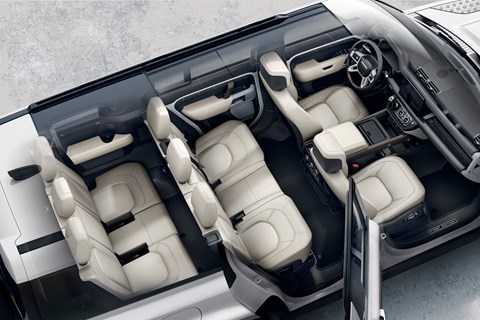
Strangely, the Defender 130’s engine range is a little more limited. You can have it with the firm’s 297bhp or 396bhp 3.0-litre straight-six petrol engines or the 296bhp 3.0-litre straight-six diesel. No PHEV of V8 options here, sadly. However, you do get a few more colour and trim options, and tech like four-zone climate control is fitted as standard. Prices start from £73,895.
I’ve changed my mind – I want a fast Defender
Land Rover’s well ahead of you. The company has already launched a version powered by a 518bhp supercharged 5.0-litre V8 engine, which is enough grunt to shove the Defender from 0–60mph in 4.9 seconds. Even more frighteningly, it’ll do 149mph flat out.
You can have it in both 90 and 110 body styles – but the extra performance doesn’t come cheap. Prices for the most basic short-wheelbase model start from £108,000, while the cheapest mid-length model is more than £111,000. And you’ll probably need to budget the same again for running costs.
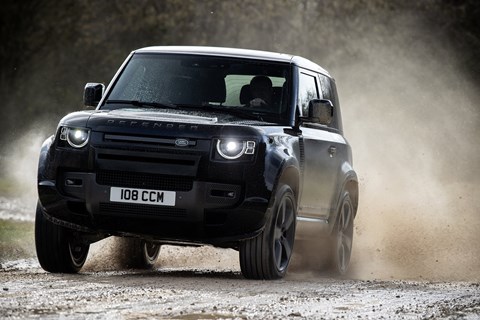
Land Rover says the Defender V8 can return 19.1mpg, but we doubt you’ll manage that unless your feet are made of feathers and aerogel. What’s more, its official CO2 emissions figure is 334g/km, which puts it firmly in the highest road tax bracket.
New Land Rover Defender: tech specs
The latest Defender is internally codenamed L663. It’s switched from the body-on-frame construction of its predecessor to an aluminium monocoque derived from the D7 platform of its Range Rover, Range Rover Sport and Land Rover Discovery siblings.
This means the latest Defender has switched from solid axles to doubles wishbones up front and independent rear suspension. Buyers can opt for either coil-spring or air suspension on the 90 models, although the 110 is only available with the latter setup.
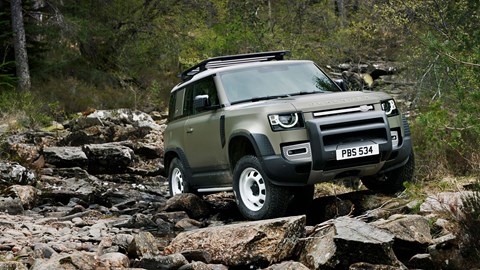
Land Rover’s air suspension system can lower the Defender’s ride height by 50mm for more refined motorway cruising. It can also raise it up to a maximum of 145mm (for 291mm of ground clearance overall) for when the body needs a brief lift to clear obstacles.
Although the Defender’s chassis is related to that of Land Rover’s other cars, it’s 95% new. As such, Land Rover issued it with its own ‘D7x’ nameplate, in which the ‘X’ denotes ‘extreme.’ Land Rover says the platform is the strongest, stiffest structure it’s ever engineered, with torsional rigidity of 30kNm/Degree. To put that figure into perspective, that’s slightly better than a Jaguar E-Pace SUV.

The Defender’s wheelbases are unrelated to any other D7-based cars (or indeed the imperial measurements the 90 and 110 badges once represented). The car is also much bigger than it was before – the 90 and 110 models measure 4583mm and 5018mm long respectively (including the spare wheel on the rear door), which is up 722mm and 440mm on previous models.
There’s new off-road technology too, including the ClearSight GroundView setup that projects a picture of the ground normally hidden by the bonnet onto the central touchscreen. The system first debuted on the Mk2 Evoque. Land Rover’s familiar Terrain Response system also now has four individual profiles that owners can configure to their liking.
Land Rover Defender: a brief history
Land Rover broke into the off-road passenger car segment in 1948 with the Series I (the mint green car in the image below was the first one the company ever made). It was introduced at the 1948 Amsterdam Motor Show with simple mechanicals, a tough box-welded chassis and aluminium body panels, because steel was hard to get in the austere post-war period.
Over the next 37 years, Land Rover refined the formula, launching the Series II in the late 1950s and the Series III in the early 1970s. The box-welded chassis remained a constant across the generation changes, although each update brought more powerful engines and a few styling tweaks. The most notable change was the headlight placement – the Series II’s headlights were mounted in its radiator grille, while the Series III’s were mounted in the front wings.
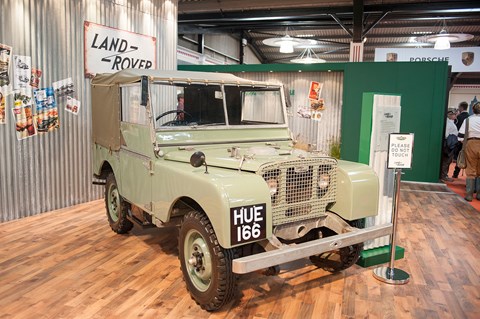
Land Rover tweaked its off-roader again in the early 1980s, altering the Series III into the boxy SUV icon loved by farmers and city-slicking hipsters alike. The Defender badge was nailed the off-roader’s rear in the early 1990s – and the car remained on sale, basically unchanged, until 2016. The image below shows how the previous Defender looked towards the end of its life.
Although the styling remained a constant, Land Rover was forced to shoehorn lots of different engines under the Defender’s bonnet between the 1990s and mid-2010s to keep pace with ever-changing emissions regulations. The brand borrowed engines from the likes of BMW, Ford and Jaguar, the latter of which lent out its supercharged 5.0-litre V8 engine for the special edition Defender Works V8, commissioned to celebrate the 4×4’s 70th anniversary.
